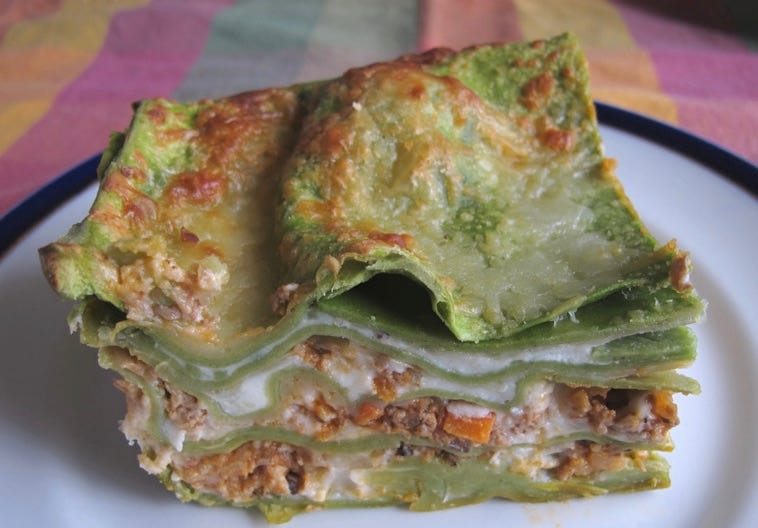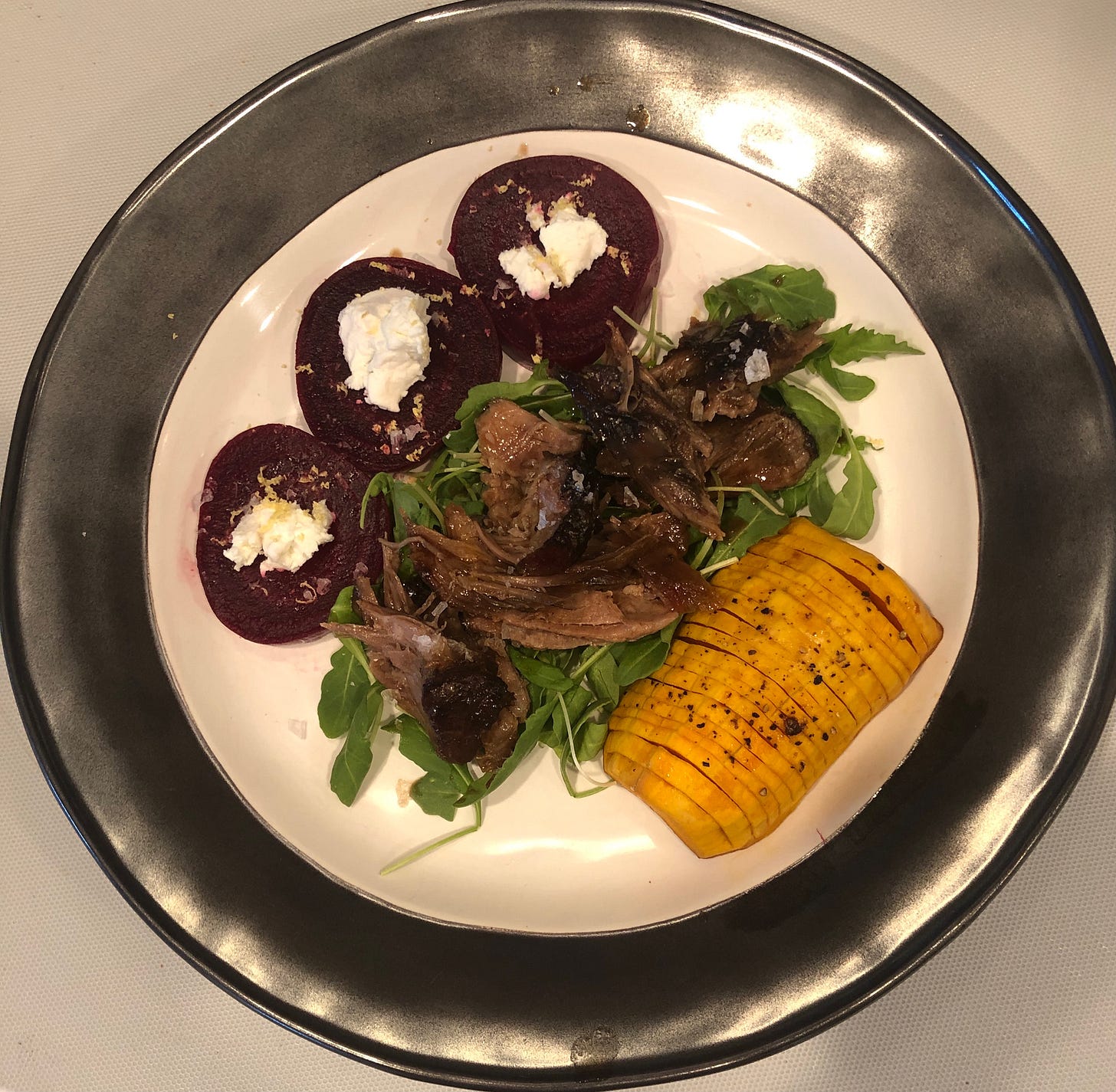BID ADIEU TO YOUR WINTER KITCHEN
Lasagne with spinach noodles~ten-hour Blackberry Farm braised lamb neck with honeynut squash, roasted beets and goat cheese dusted with lemon zest, arugula with cherries
Spinach Lasagne alla Bolognese
Before heading into months of warm-weather grilling, I luv to cap off cooking in my winter kitchen with something baked or braised. Winter always equals baked pasta for me. This recipe is my all-time favorite. First, I took a 10-page Google dive into the internet for lasagna so you wouldn’t have to. I also consulted my memory of TIME-LIFE Foods of the World. There I found a lasagne recipe made with spinach noodles and a white sauce called béchamel made with butter, flour, and milk. No tomato sauce! This delicate recipe has stayed with me for decades. So, when a dear friend requested I make it again, I was on it.
For starters, here’s a guide from The Clever Carrot to making homemade lasagna noodles. Take note, there are several versions of lasagna from different regions of Italy. If you hunger for even more variety, check out two dozen more versions at The Spruce Eats.
There are two types of lasagna alla bolognese, both of which come from the Emilia-Romagna region of Italy. In the U.S., we are most accustomed to lasagna pasta sheets being pale yellow, but the more traditional lasagna recipe calls for green pasta, ala The Spinach Tiger, made from spinach. I like to buy sheets of spinach pasta to save time if I can find them, at some—but not all—Whole Foods, plus some specialty markets or grocery stores. In both cases, beef is only a minor ingredient in this bolognese. Ground veal, pork, ham, and lamb are dominant. Parmigiano-Reggiano and béchamel are also primary.
[Recipe adapted from TIME-LIFE Foods of Italy published in 1968.]
BECHAMEL
Ingredients
3 Tbsp butter
6 Tbsp flour
2 cups chicken or vegetable stock
2 cups whole milk
1 cup heavy cream
pinches of ground nutmeg
1 tsp sea salt
1/2 cup freshly grated Parmesan cheese
Directions
In a heavy 2- to 3-quart saucepan, melt the butter over moderate heat and stir in the flour.
Remove the pan from the heat and pour in the milk and cream all at once, beating with a whisk until the flour is partially dissolved. Return the pan to the heat and cook, stirring constantly with the whisk.
When the sauce comes to a boil and thickens into a smooth cream, reduce the heat and simmer, still stirring, for 2 to 3 minutes. Remove from heat and season with nutmeg and salt.
BOLOGNESE
To make 2-1/2 cups
Ingredients
1/4 pound smoked ham, coarsely chopped (about 1 cup)
1 cup coarsely chopped onion
1/4 cup coarsely chopped carrots
1/2 cup coarsely chopped celery
4 Tbsp butter
2 Tbsp olive oil
1/4 pound ground beef
1/4 pound ground lean pork
1/4 pound ground veal
1/4 pound ground lamb
1/2 cup dry white wine
2 cups stock (chicken or vegetable)
2 cups red or white wine
1 cup whole milk
ground nutmeg to taste
salt
freshly ground pepper
Optional ingredients: pine nuts, garlic, parsley, fresh thyme, fresh basil, mozzarella, pecorino romano, porcini mushrooms, pancetta, guanciale, chicken, chicken livers.
Directions
Combine the chopped ham, onions, carrots, and celery on a cutting board and chop together into very small pieces.
Melt 2 Tbsp of butter over moderate heat in a heavy 10- 12-inch skillet. When the foam subsides, add the mixture and cook, stirring frequently for 10 minutes or until lightly browned.
Transfer to a heavy 3- to 4-quart saucepan. Heat 2 Tbsp of olive oil in the same skillet. Cook the beef, veal, lamb, and pork over moderate heat, stirring constantly to break up until the meats loose their color.
Stir in stock, wine, and milk. Bring to a boil, then reduce and simmer, partially covered for 2 hours or more, stirring occasionally.
,
ASSEMBLY
Spread a layer of bolognese about 1/4 inch deep evenly over the bottom of a buttered casserole.
Spread over it about 1 cup béchamel. Lay the lasagne on top, overlapping the strips slightly or not. Repeat the layers two more times, alternating as before. Allow about 2 inches to hang over the edge of the dish with the last layer, which you should fold over the top of the lasagne. Top with the rest of the bolognese and béchamel. Sprinkle with grated Parmesan.
Cover with aluminum foil, bake for 40 minutes at 375 degrees, remove the foil, and bake 10 more minutes or until the top has a nice crust. Let cool 15 minutes before serving.
Ten-Hour Braised Lamb Neck
I've cooked uber special dinners before. The first time was decades ago on New Year's Eve. That dish was salmon en croute—salmon Wellington. A friend and I worked most of the day on it, only to toss the utterly failed dish in the garbage. The idea, however, was terrific! The execution and technique were pitiful! With this year’s New Year's Eve dish I knew it would be a three-day effort. One that would undoubtedly be worth the effort. However, I wasn't sure of myself every step of the way since I've only made it once . . . with sweet success years ago. And to put a bookend on this year’s winter season of cooking, I made it again recently, with spectacular success.
A couple of weeks back, I bought the lamb. I purchased twice the weight of meat needed for the recipe but didn't figure that out until way into the cooking process. Live and learn. This lamb recipe is from a most remarkable cookbook. The Blackberry Farm Cookbook published by an intimate luxury inn—truly one of my favorite places on planet earth!—nestled in 4,000 acres in the Great Smoky Mountains called Blackberry Farm. (A newer sister property, Blackberry Mountain, a wellness culinary adventure, sits a couple miles down a winding road.) BBF, itself, is so isolated that not a single other building can be seen from horizon to horizon from its front porch. Before making this dish the first time, I'd never even imagined a recipe such as "Ten-Hour Braised Lamb Neck." Recalling that the first time I made it, ate it, and ever since just not being able to get it out of my head, there was surely no doubt it was worth repeating. This time, however, I had to substitute the neck with a block—a cut that includes part neck and part shoulder. No worries. That cut was the only one I could put my hands on this particular holiday.
But before those 10 hours of cooking the lamb in a 250-degree oven with aromatics and red wine and stock, the normally fatty, bony, gristly cut seemed unworthy. But it was an unctuous, flavor-filled delight. The meat was harvested from the block with a fork in what became a culinary mining expedition. To serve, the lamb was then dipped in the juices left over from its roasting, then placed on a bed of arugula—a most gratifying, full-flavored, moist indelibly memorable meat. But how to present the beets? It took me hours over a couple of days earlier to decide to simply cut them into 3/4-inch slices and top with a dollop of fresh goat cheese and dust with lemon zest. And the honeynut squash? Didn't do anything to the squash other than cut it hasselback style. Its color and appearance after slicing nicely sufficed. This is one final winter dinner where the main and each side were as otherworldly as the other, no matter what order we ate them in . . . .
Thank you for reading [VINTAGE MORELS] Adventures With A Home Cook.
![[VINTAGE MORELS] adventures with a home cook](https://substackcdn.com/image/fetch/$s_!EKrq!,w_80,h_80,c_fill,f_auto,q_auto:good,fl_progressive:steep,g_auto/https%3A%2F%2Fsubstack-post-media.s3.amazonaws.com%2Fpublic%2Fimages%2Ffa5d998f-e036-4ca5-8421-d2d7bc6558e2_335x335.png)

![[VINTAGE MORELS] adventures with a home cook](https://substackcdn.com/image/fetch/$s_!EKrq!,w_36,h_36,c_fill,f_auto,q_auto:good,fl_progressive:steep,g_auto/https%3A%2F%2Fsubstack-post-media.s3.amazonaws.com%2Fpublic%2Fimages%2Ffa5d998f-e036-4ca5-8421-d2d7bc6558e2_335x335.png)



(email from another friend) "Looks delicious. But we can’t eat meat. Is there a duck or chicken substitute? I know, I know, it won’t be real Bolognese without the beef, pork, veal, etc."
(email from a friend) "My mind swims with mouth-watering, home-filling aromas. Thanks!😋"